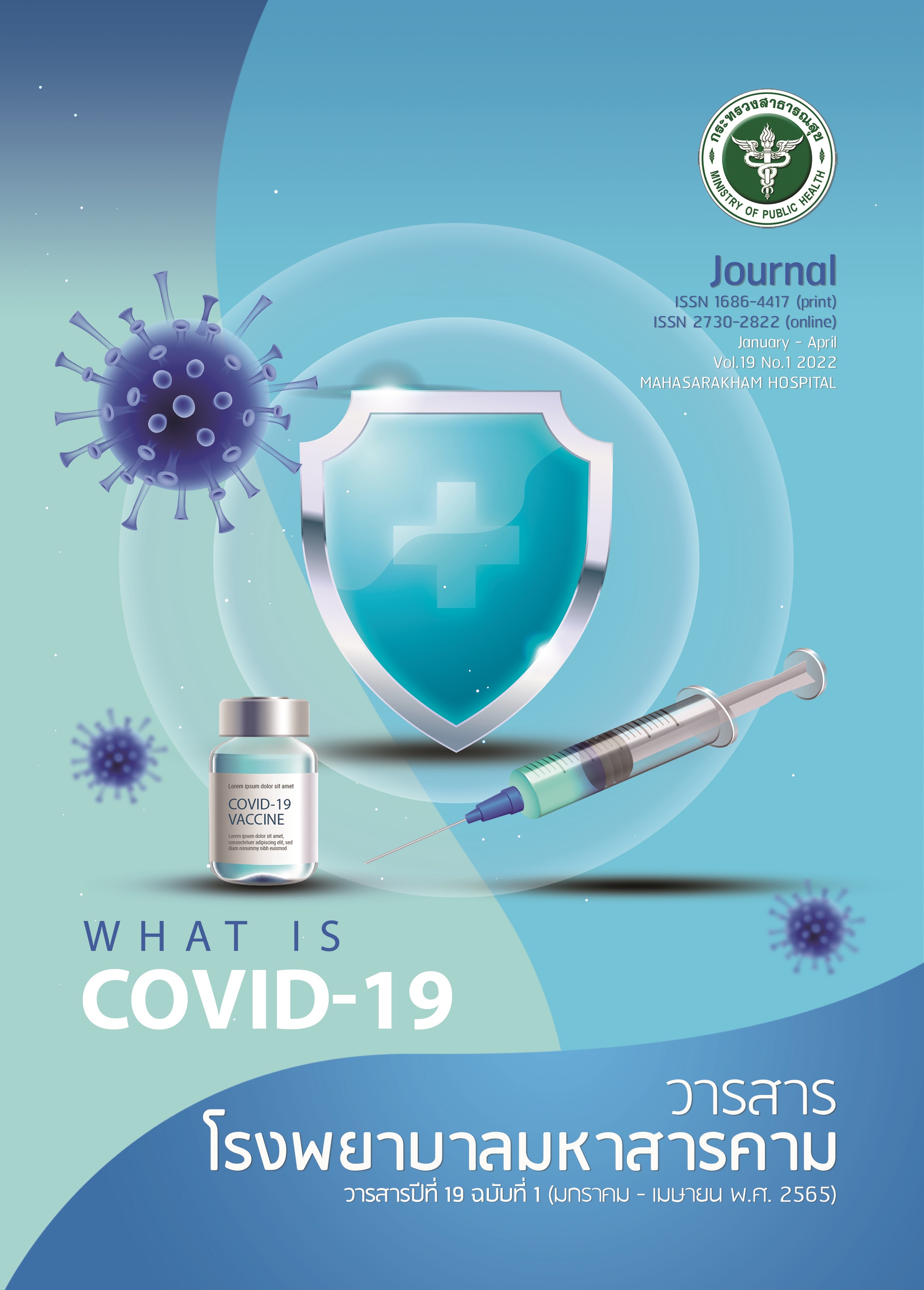ผลลัพธ์การให้ยาไฮโดรคอร์ติโซนและไทอะมีนในผู้ป่วยติดเชื้อเมลิออยโดสิสในกระแสเลือด ในโรงพยาบาลมุกดาหาร
คำสำคัญ:
ไม่มีบทคัดย่อ
บทคัดย่อ
โรคติดเชื้อเมลิออยโดสิสในกระแสเลือด เป็นโรคที่มีอัตราการเสียชีวิตสูงเพื่อศึกษาผลการใช้ยาไฮโดรคอร์ติโซนและไทอะมีน ในการรักษาผู้ป่วยติดเชื้อเมลิออยโดสิสในกระแสเลือด เป็นการศึกษาแบบย้อนหลังเชิงวิเคราะห์ ศึกษาข้อมูลในเวชระเบียนของผู้ป่วยติดเชื้อเมลิออยโดสิสในกระแสเลือด ที่ได้รับการรักษาแบบผู้ป่วยใน โรงพยาบาลมุกดาหาร ระหว่างวันที่ 1 มกราคม 2563 ถึง วันที่ 31 ธันวาคม 2563 เปรียบเทียบกลุ่มที่ได้รับยาไฮโดรคอร์ติโซนและไทอะมีน กับกลุ่มที่ไม่ได้รับยา
ผลการศึกษา ข้อมูลผู้ป่วยที่เข้าเกณฑ์วิจัย 90 ราย เป็นกลุ่มที่ได้รับยาไฮโดรคอร์ติโซนและไทอะมีนร่วมกับยาปฏิชีวนะ 46 ราย กลุ่มที่ไม่ได้ได้รับยาไฮโดรคอร์ติโซนและไทอะมีนโดยได้ยาปฏิชีวนะอย่างเดียว 44 ราย พบว่ากลุ่มที่ได้รับยา เป็นเพศชาย 28ราย (ร้อยละ60.9) อายุเฉลี่ย(SD) 56.8 (13.2) ปี โรคประจำตัวพบ เบาหวาน 31 ราย (ร้อยละ 67.4) อาการทางคลินิกที่พบร่วมมากที่สุดคือภาวะไตวายเฉียบพลัน 23 ราย (ร้อยละ50.0) กลุ่มที่ไม่ได้รับยา เป็นเพศชาย 24 ราย (ร้อยละ54.5) อายุเฉลี่ย(SD) 55.0 (12.9) ปี โรคประจำตัวพบ เบาหวาน 24 ราย (ร้อยละ54.5) อาการทางคลินิกที่พบร่วมมากที่สุดคือภาวะไตวายเฉียบพลัน 23 ราย (ร้อยละ52.3) กลุ่มที่ได้รับยามีผู้ป่วยเสียชีวิต 4 ราย (ร้อยละ8.7) กลุ่มที่ไม่ได้รับยามีผู้เสียชีวิต 11 ราย (ร้อยละ25.0) มีความแตกต่างกันอย่างมีนัยสำคัญทางสถิติ (p = .038)
สรุป การได้รับยาไฮโดรคอร์ติโซนและไทอะมีน ร่วมกับยาปฏิชีวนะในการรักษา ผู้ป่วยติดเชื้อเมลิออยโดสิสในกระแสเลือด สามารถลดอัตราการตายได้อย่างมีนัยสำคัญทางสถิติ
คำสำคัญ: การติดเชื้อเมลิออยโดสิสในกระแสเลือด, เมลิออยโดสิส, ไฮโดรคอร์ติโซน, ไทอะมีน
เอกสารอ้างอิง
เอกสารอ้างอิง
กระทรวงสาธารณสุข. [เข้าถึงเมื่อ 1 เมษายน 2564]. เข้าถึงได้จาก: https://hdcservice.moph.go.th/hdc/reports/report.php?source=pformated/format1. php&cat_id=144fdf97a756b3f82dce197287e06316&id=00366a85bd3c2b6932a228df29137252.
ภัทรพงษ์ พีรวงศ์, ธงชัย สิทธิยุโณ. ปัจจัยที่มีความสัมพันธ์ต่อการตายของผู้ป่วยติดเชื้อเมลิออยโดสิสในกระแสเลือดในโรงพยาบาลบุรีรัมย์. วารสารการแพทย์ โรงพยาบาลศรีษะเกษ สุรินทร์ บุรีรัมย์. 2548;20(3);11-26.
สุเทพ จันทรเมธีกุล. โรคติดเชื้อในกระแสเลือดจากเชื้อเมลิออยโดสิส. ขอนแก่นเวชสาร. 2554;35(1),9-14.
Hantrakun V, Kongyu S, Klaytong P, Rongsumlee S, Day NPJ, Peacock SJ, et al. Clinical Epidemiology of 7126 Melioidosis Patients in Thailand and the Implications for a National Notifiable Diseases Surveillance System. Open Forum Infect Dis. 2019;6(12):ofz498. Doi: 10.1093/ofid/ofz498.
Wright SW, Kaewarpai T, Lovelace-Macon L, Ducken D, Hantrakun V, Rudd KE, et al. A Two Biomarker Model Augments Clinical Prediction of Mortality in Melioidosis. Clin Infect Dis. 2021;72(5): 821–828.
Venkatesh B, Finfer S, Cohen J, Rajbhandari D, Arabi Y , Bellomo R, et al. Adjunctive Glucocorticoid Therapy in Patients with Septic Shock. N Engl J Med 2018;378(9):797-808.
Gibbison B, Lopez-Lopez JA, Higgins JPT, Miller T, Angelini GD, Lightman SL, et al. Corticosteroids in septic shock: a systematic review and network meta-analysis. Critical Care. 2017;21:78. Doi: 10.1186/s13054-017-1659-4.
Teng J, Pourmand A, Mazer-Amirshahi M. Vitamin C: The next step in sepsis management?. J Crit Care. 2018;43:230-234. Doi: 10.1016/j.jcrc.2017.09.031.
Wilson JX, Wu F. Vitamin C in sepsis. Subcell Biochem.2012;56:67-83. Doi: 10.1.7/978-94-007-299-95.
Tyml K. Vitamin C and Microvascular Dysfunction in Systemic Inflammation. Antioxidants (Basel). 2017;6(3):49. Doi: 10.3390/antiox6030049.
Marik PE, Khangoora V, Rivera R, Hooper MH, Catravas J. Hydrocortisone, Vitamin C, and Thiamine for the Treatment of Severe Sepsis and Septic Shock: A Retrospective Before-After Study. Chest. 2017;151(6):1229-1238. Doi: 10.1016/j.chest.2016.11.036.
Chang P, Liao Y, Guan J, Guo Y, Zhao M, Hu J, et al. Combined Treatment with Hydrocortisone, Vitamin C, and Thiamine for Sepsis and Septic Shock: A Randomized Controlled Trial. Chest. 2020;158(1):174-182. Doi: 10.1016/j.chest.2020.02.065.
Chierakul W, Anunnatsiri S, Chaowagul W, Peacock SJ, Chetchotisakd P, Day NP. Addition of trimethoprim-sulfamethoxazole to ceftazidime during parenteral treatment of melioidosis is not associated with a long-term outcome benefit. Clin Infect Dis. 2007;45(4):521-3. Doi: 10.1086/520010.
Chierakul W, Anunnatsiri S, Short JM, Maharjan B, Mootsikapun P, Simpson AJH, et al. Two randomized controlled trials of ceftazidime alone versus ceftazidime in combination with trimethoprim-sulfamethoxazole for the treatment of severe melioidosis. Clin Infect Dis. 2005;41(8) 1105-13. Doi: 10.1086/444456.
Currie BJ. Melioidosis: evolving concepts in epidemiology, pathogenesis, and treatment. Semin Respir Crit Care Med. 2015;36:111-25. Doi: 10.1055/s-0034-1398389.
Abraham E. New Definitions for Sepsis and Septic Shock: Continuing Evolution but With Much Still to Be Done. JAMA. 2016; 315(8):757-759.
Kellum JA, Lameire N, Aspelin P, Barsoum RS, Burdmann EA, Goldstein SL, et al. Kidney disease: improving global outcomes (KDIGO) acute kidney injury work group. KDIGO clinical practice guideline for acute kidney injury. Kidney international supplements. 2012;2:1-138.
William AK, Elizabeth AD, Douglas PW, Jack EZ. APACHE II: a severity of disease classification system. Critical Care Medicine.1985;13:818-29.
Cheng AC, Stephens DP, Anstey NM, Currie BJ. Adjunctive Granulocyte Colony-Stimulating Factor for Treatment of Septic Shock Due to Melioidosis. Clin Infect Dis.2004;38(1):32-7. Doi: 10.1086/380456.
ดาวน์โหลด
เผยแพร่แล้ว
รูปแบบการอ้างอิง
ฉบับ
ประเภทบทความ
สัญญาอนุญาต
ลิขสิทธิ์ (c) 2022 วารสารโรงพยาบาลมหาสารคาม

อนุญาตภายใต้เงื่อนไข Creative Commons Attribution-NonCommercial-NoDerivatives 4.0 International License.
วารสารนี้เป็นลิขสิทธิ์ของโรงพยาบาลมหาสารคาม






